Learn how your retirement savings can be used to establish or sustain a legacy, instead of burdening your loved ones with unwelcome tax consequences.

Many people are saving more for retirement, and the number people who have accumulated at least $1 million in their retirement accounts reached an all-time high in 2019, according to recent data from Fidelity Investments.
If you have diligently saved as you’ve built your career, preparing for the future and ensuring that the blessings you have enjoyed will last a lifetime, your retirement plan may be one of your biggest assets. Employer-sponsored 401(k) plans, individual retirement accounts (IRAs), Keogh plans, and other retirement savings vehicles provide tax-advantaged ways to prepare for the future. But many people don’t realize that they may also be useful vehicles to establish or sustain a legacy of philanthropy that lasts in perpetuity.
Taxing Retirement Plan Issues
Funds remaining in your retirement account after you die will be passed to the beneficiary you named on the account. If you’re married, that will likely be your spouse, or you may have named another close family member or friend. Because the beneficiary designation determines who will take ownership of the account after you die, the individual will likely have access to the funds quickly.
But what happens next can hold unwelcome surprises. Your beneficiary may face tax consequences that can come in two forms:
Income tax: Like many, you may have a traditional retirement account that you funded with pre-tax income. If your employer subsidized your plan, you may have also received a matching contribution, up to a predetermined cap. When you withdraw income from the traditional account after age 59 and a half, or when you make required minimum distributions (RMDs) after age 70, you must pay income tax on both the original contributions and their earnings.
The plan documents and federal law will dictate whether your beneficiary can hold the money in the plan to avoid paying the income taxes due when they inherit the fund. However, some plans may require them to take a lump-sum distribution, where all of the money is disbursed at one time. This may result in a large taxable event, whether your beneficiary needs the money or not.
Estate tax: If your overall estate is worth more than $11.4 million — or $22.8 million for a married couple — the amount in excess of that value, including your retirement account, may be subject to federal estate tax, also called inheritance tax. In addition, 18 states have their own estate taxes, which may apply to estates worth as little as $1 million. As a result, as much as 60 percent of your estate may be eliminated through inheritance taxes.
So, the inheritance of a traditional retirement plan can end up being a confusing and expensive event if it is not managed properly.
The Gift of Gifts
One way to mitigate the tax consequences of an inherited retirement plan is through charitable giving. When you designate a nonprofit organization as your plan beneficiary, the funds are used to support causes that are important to you, and your heirs won’t be left with the burden of extra taxes. You receive a number of benefits, including:
- Regular lifetime withdrawals, which may be taken when needed.
- Flexibility to change beneficiaries if your family’s needs change during your lifetime.
- The ability to avoid the potential double taxation on retirement account assets.
When you name a nonprofit organization like the Catholic Community Foundation as your plan beneficiary, you retain full control of your retirement assets during your lifetime. Upon your death, the remaining funds are treated as a tax-deductible donation to the Foundation, supporting the Catholic causes that are so important to you.
Taking advantage of this creative estate planning strategy, requires just a few simple steps:
- Contact your plan administrator and name the Catholic Community Foundation as a beneficiary of your IRA, 401(k), or other qualified retirement plan.
- Inform the Foundation about your planned gift and let us know of any specific Archdiocesan parish, school or ministry endowment fund you would like this gift to support. Your plan administrator is not obligated to notify the beneficiary of the change.
- The balance of your retirement account, tax-free, will directly benefit the Foundation upon your passing.
Use the nest egg you have saved over a lifetime to leave a legacy of faith while still providing for your family during your lifetime and alleviating the burden of taxes after you’re gone. For more information on naming the Catholic Community Foundation as your beneficiary, please contact us so we may answer your questions and provide any help you need through the process.



